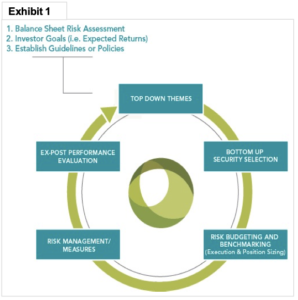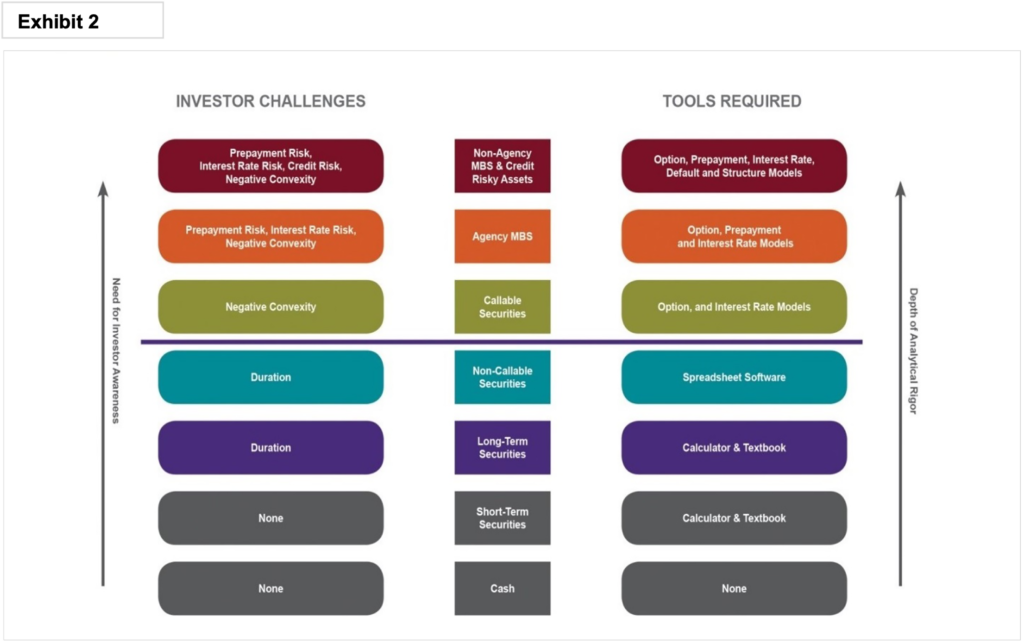
Fundamental Investing Principles for Banks
Brought to you by ALM First

A bank’s liability mix is a significant competitive advantage that acts as an organic interest rate hedge for both the assets in the investment portfolio and the full balance sheet.
There are many opportunities in the fixed income universe right now, given the significant increase in both yields and yield spreads. In such a volatile interest rate environment, a thorough investment process becomes even more critical in evaluating such opportunities. We advise all of our financial institution clients to focus on process, rather than considering individual investment options in the context of the rate outlook. Regardless of any bank’s specific objective for its portfolio, the ultimate goal should be to maximize return per unit of risk taken.
It’s critical that banks have a well-defined investment process and decision-making framework to ensure the portfolio generates reasonable risk-adjusted returns. A successful fixed income manager should use both rigorous trading-level analytical models and a data- and research-oriented framework. As a best practice, managers should also consider relative value analysis using robust trading level analysis in an option and credit adjusted framework.
Exhibit 1 displays a portfolio management process that begins with an assessment of the overall balance sheet risk profile.
Banks should manage the securities portfolio within a sound asset liability management framework, which accounts for the balance sheet’s existing relationship between the asset and liability risk profiles. Depository investors don’t manage their investment portfolios in a vacuum; overall balance sheet interest rate, liquidity and credit risks should be considered in the development of the investment strategy and overall portfolio objectives. Once executives establish portfolio objectives, it’s important to ensure the guidelines/policy allow for successful implementation of the strategy.
From here, top-down market themes lead the way through the investment process. Top-down themes communicate the current assessment of various market metrics and risk factors, which drive sector allocation decisions. Security selection, risk budgeting and risk measurement round up the assessment, followed by post-performance evaluation.
Actively managed fixed income portfolios are at some stage of this process at all times. It’s important to note that there’s no discussion here on the direction of rates or when and how the Federal Reserve is going to move. Portfolio management decisions dependent upon a particular path of interest rates have no place in this in this process. Instead, portfolio performance comes from risk measurement and management, as well as sector and security selection.
Why Banks Need Analytical Models
It’s vital that banks have analytical models to identify and measure risks and potential returns. In today’s dynamic fixed income markets, the complexity of the assets or asset classes means there’s an increased need for robust models.

Exhibit 2 shows this graphically. The line in the sand is clearly drawn between option and credit embedded assets and their other, simpler cousins.
Mortgage-backed securities are better evaluated using Monte Carlo simulations, given the path-dependent nature of the prepayment option, while it’s best to evaluate callable bonds using a lattice approach. Interest rate and option models should price market instruments accurately and be arbitrage free; prepayment models should exhibit a “best data fit” approach. Without these tools, banks will be unable to properly evaluate market pricing of such assets.
Don’t forget the popular phrases “model users beware” and “use models at own risk.” Models are only as good as the assumptions that go into them, requiring human capital investments to properly manage robust analytical systems. Proceed cautiously: understand the inputs and assumptions and be critical of outputs. That’s why feedback loops are such an important component of the overall investment process: Models can help us make decisions, but they are not the end all, be all.
Third-Party Considerations
A growing number of banks are turning to experienced external advisors, both for guidance and to outsource specialized functions like investment and balance sheet advisory. An institutional asset manager can provide the tools and resources – both systems and human capital -to build and maintain high performing bond portfolios at a fraction of what it may cost to attain those resources internally.
When seeking outside counsel on investing, banks must understand how that advisor is compensated, such as fee based or commission, and measure performance relative to the stated portfolio objectives. That said, a thoughtful and disciplined investment process can lead to more consistent and predictable earnings from the fixed income portfolio.
Legal Disclosure:
ALM First Financial Advisors is an SEC registered investment advisor with a fiduciary duty that requires it to act in the best interests of clients and to place the interests of clients before its own; however, registration as an investment advisor does not imply any level of skill or training. ALM First Financial Advisors, LLC (“ALM First Financial Advisors”), an affiliate of ALM First Group, LLC (“ALM First”), is a separate entity and all investment decisions are made independently by the asset managers at ALM First Financial Advisors. Access to ALM First Financial Advisors is only available to clients pursuant to an Investment Advisory Agreement and acceptance of ALM First Financial Advisors’ Brochure. You are encouraged to read these documents carefully. All investing is subject to risk, including the possible loss of your entire investment.
The content in this article is provided for informational purposes and should not be relied upon as recommendations or financial planning advice. We encourage you to seek personalized advice from qualified professionals regarding all personal finance issues. While such information is believed to be reliable, no representation or warranty is made concerning the accuracy of any information presented. Statements herein that reflect projections or expectations of future financial or economic performance are forward-looking statements. Such “forward-looking” statements are based on various assumptions, which assumptions may not prove to be correct. Accordingly, there can be no assurance that such assumptions and statements will accurately predict future events or actual performance. No representation or warranty can be given that the estimates, opinions or assumptions made herein will prove to be accurate. Actual results for any period may or may not approximate such forward-looking statements. No representations or warranties whatsoever are made by ALM First Financial Advisors as to the future profitability of investments recommended by ALM First Financial Advisors.
© 2022 ALM First Group, LLC. All rights reserved.


